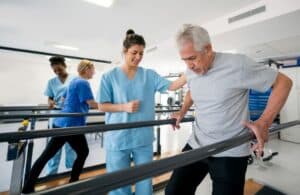
Within the intricate landscape of healthcare, rehabilitation in acute care is an indispensable component that often goes beyond the traditional boundaries of treatment. Anthony Misitano, founder of PAM Health, points out that when individuals confront sudden, severe health challenges like strokes, traumatic injuries, or surgeries, rehabilitation becomes the linchpin in the process of recovery. This article delves into the multifaceted aspects of rehabilitation within the acute care setting, shedding light on its impact on patient’s lives and healthcare.
Understanding Acute Care and Rehabilitation
Acute care, or critical care, is the prompt and intensive treatment for individuals grappling with severe health conditions or injuries. This specialized medical care emphasizes stabilizing the patient’s condition and intervening with appropriate medical procedures. However, it is worth noting that acute care is not solely focused on immediate treatment but seamlessly integrates rehabilitation into the overall continuum of care.
Rehabilitation in acute care is not an isolated process but an integral component that begins early on in the patient’s journey. Incorporating rehabilitation from the early stages fosters a holistic approach to recovery. This comprehensive approach considers the immediate medical needs and the individual’s long-term healing and functional restoration. Through medical expertise, therapeutic interventions, and ongoing support, acute care aims to facilitate a successful recovery and improve patients’ overall quality of life.
Early Mobilization and Functional Restoration
A cornerstone of rehabilitation in acute care is the concept of early mobilization. Traditionally, bed rest was considered a standard practice for recovery. However, contemporary research has shown that early movement and physical activity significantly improve outcomes. Rehabilitation specialists collaborate closely with medical teams to initiate gentle exercises, range of motion activities, and mobility exercises tailored to the patient’s condition.
By addressing mobility early on, rehabilitation aims to prevent complications such as muscle atrophy, joint contractures, and loss of independence. Physical therapists play a pivotal role in guiding patients through exercises that enhance physical strength and boost confidence and motivation, laying a solid foundation for the overall recovery journey.
Cognitive Rehabilitation and Improvement
In addition to addressing physical aspects, acute care rehabilitation extends its purview to cognitive functions. Patients recovering from neurological conditions or surgeries often face cognitive challenges that can impact their daily lives. Occupational therapists play a vital role in cognitive rehabilitation by employing strategies to improve memory, attention, problem-solving, and decision-making skills.
Speech-language pathologists also contribute significantly to cognitive rehabilitation by addressing communication disorders, speech difficulties, and swallowing issues. PAM Health founder, Anthony Misitano, points out that this comprehensive approach ensures that patients recover physically and regain control over their cognitive faculties, fostering a more complete and sustainable recovery.
Psychosocial Support and Emotional Well-Being
The acute care environment can be emotionally taxing for patients and their families. Recognizing the interconnectedness of physical and mental health, rehabilitation professionals integrate psychosocial support into the treatment regimen. Psychologists and social workers collaborate with the medical team to provide counseling, support groups, and coping strategies to help individuals and their families navigate the emotional challenges associated with sudden health crises.
Addressing mental health aspects becomes fundamental to achieving a comprehensive and sustainable recovery. By fostering emotional well-being and focusing on the psychological needs of patients, rehabilitation not only aids in restoring physical function but also contributes to the overall resilience and adaptability of individuals in the face of adversity. By providing support, therapy, and resources tailored to mental health, patients can develop coping mechanisms, build positive habits, and cultivate a strong support network, all crucial for long-term well-being and successful recovery.
Transitioning to Independence
Rehabilitation in acute care is a dynamic and evolving process that adapts to the changing needs of patients. As individuals regain strength and function, the focus shifts toward preparing them for a seamless transition back to their homes and communities. This involves not only physical rehabilitation but also training in activities of daily living (ADLs) and, if necessary, the use of mobility aids.
Occupational therapists play a central role in this phase, collaborating with patients to tailor rehabilitation plans that align with their personal goals. Whether it’s relearning how to cook, dressing independently, or utilizing assistive devices, the rehabilitation team empowers individuals to reclaim their independence step by step, fostering a sense of control over their lives.
Interdisciplinary Collaboration
The success of rehabilitation in acute care hinges on effective interdisciplinary collaboration. Physiotherapists, occupational therapists, speech-language pathologists, psychologists, nurses, and physicians work cohesively as a multidisciplinary team to address the diverse needs of patients. Regular communication, through meetings and shared documentation, allows for exchanging valuable insights and updates on each patient’s progress.
By establishing shared goals and a holistic approach that considers recovery’s physical, cognitive, and emotional aspects, the chances of achieving a successful rehabilitation outcome are greatly optimized. This collaborative effort ensures that patients receive comprehensive and personalized care, enabling them to regain their independence and improve their quality of life.
Conclusion
In the intricate tapestry of acute care, rehabilitation emerges as a guiding thread, weaving together physical, cognitive, and emotional aspects of recovery. By fostering early mobilization, cognitive rehabilitation, psychosocial support, and a focus on independence, rehabilitation professionals become catalysts for transformation. The role of rehabilitation in acute care is not just about restoring function; it’s about rebuilding lives and empowering individuals to reclaim their independence.